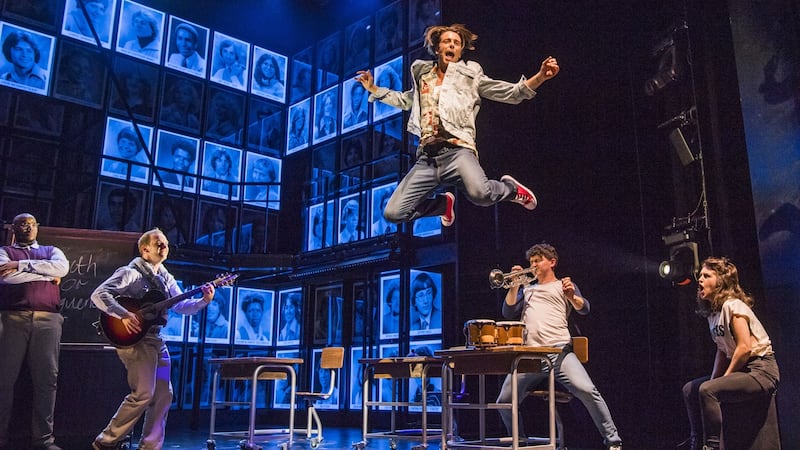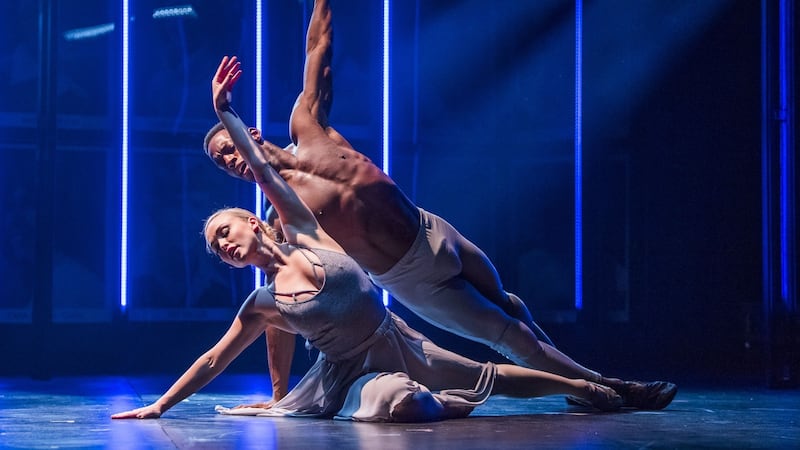I’m standing in the wings in Zurich’s MAAG Halle watching three cast members of Fame the Musical running through some dance routines, when the stage manager suggests I join in. It occurs to me they have more joints than I have (I basically have the same functional design as a 1980s Star Wars figure) and so I decline.
The reality is that I’d love to be a grey-haired, slow-moving kid of Fame. As a child, I loved that original TV programme, though I didn’t quite realise then that it was set in the New York School of Performing Arts.
I thought it was set in a regular American high school. America already seemed way cooler than Ireland so the idea that people spontaneously broke into musical dance numbers wasn’t surprising to me. I also, for the record, thought The Monkees was just what happened when four dudes shared a house and that On the Town was a documentary about life in the navy.
Some elements of the stage show haven't dated too well
I wished my own life featured more spontaneous dance numbers and I’m slightly pleased to find they are actually a real thing. Jorgie Porter, who trained to be a ballerina before segueing into life on Hollyoaks and I’m a Celebrity . . . Get Me Out of Here, says they occurred regularly at her old performing arts school.
One day she might just be having her lunch, she says, “and everyone would start singing and clicking their fingers. Initially I was like ‘This is embarrassing’.” She shrugs. “But then at the end of the three years it became normal.”
“People do spontaneously start dancing,” agrees Katie Warsop, who is also the onset choreographer. She did some spontaneous dancing the other day, she says.

The original film version of Fame was based on director Alan Parker’s close observance of the real School of Performing Arts in Manhattan. It follows the struggles of eight students learning their craft, craving fame and falling foul of fame’s bleaker edges.
There’s a darkness to it that’s retained in the stage production. Some elements of the stage show haven’t dated too well (one character’s oversexed antics are played for laughs despite amounting to persistent sexual harassment) but others seem to be perpetually relevant for young performers.
‘Drug-related stuff’
“The drug-related stuff is everywhere,” says Porter’s co-star Jamal Kane Crawford, speaking of the performance-enhancing drug addiction of one of the characters. “Today, it’s more hidden and less spoken-about but it’s still about.”
Other things have changed. In the past, the very idea of a School of Performing Arts seemed like a novelty, but now in an era when many novelists have undertaken MFAs and every second musician has been to one of the BIMM music schools, it’s a more familiar notion.
I don't really want to live with celebrities. Celebrities aren't really my favourite people
Furthermore, Fame was created before today’s heightened reality television talent shows and arch musical dramas like Glee, both of which revel in showing the fame machine in action.
It touts a more old-fashioned message, that success in the arts is a fickle thing that comes as a consequence of people putting in the hours learning their craft. To quote Debbie Allen in the TV show’s intro credits: “You want fame? Well, fame costs. And right here is where you start paying . . . in sweat.”

“The message is that there is no shortcut,” says Crawford, whose hero is Gene Anthony Ray, who played Leroy in the original film and TV show but who died tragically at the age of 41. “But everything is different nowadays. Everything is easier to access. You see a life which isn’t real at a young age, the money, the glam. They don’t see the work we do.”
Porter, who has experienced real fame as both a soap and reality star, also has some thoughts on the subject. “I grew up wanting to be famous,” she says, “but wanting to be ‘ballerina famous’. Everyone wants to be famous now don’t they? But for what reason? When I was a kid it was because I wanted to sing and dance on stage or on telly.”
When she was first cast in Hollyoaks back in 2008, Porter could see the fame juggernaut advancing towards her. She recalls watching her co-stars being lauded as they danced on stages at a Liverpool club knowing that in the months to come she would be similarly well-known.
“I started when I was 20 and I was playing a 15-year-old so I’d have kids coming up going ‘Wahey!’ and I’d be like, ‘I am a grown woman don’t touch me’.” She laughs. “You could be talking to your mum this close and people would walk between you. It feels like a bit of an ownership thing.”
How did she deal with it? “Places like Harrods would be my ‘safe place’ because no one in Harrods would watch Hollyoaks and if they did, they didn’t come up to you. Posh places were my safe place.”
She feels a little funny about her reality television fame in a way she doesn’t about her acting jobs “Now when fans are at the stage door, I’m like ‘thanks!’” she says, beaming. “Doing reality TV I didn’t really feel deserving.” She sighs. “I don’t really want to live with celebrities. Celebrities aren’t really my favourite people. I didn’t want to wash Chris Eubank’s undies in a river. I didn’t ask for that.”
But would she do it again? She doesn’t hesitate. “Yeah!”
[ bordgaisenergytheatre.ie/artist/fame-the-musicalOpens in new window ]












